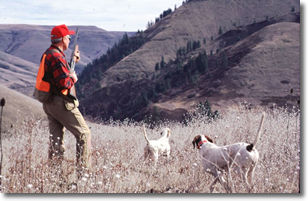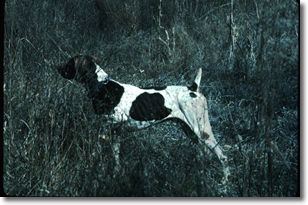 |
| A good many hunters still favor traditional gun dogs like English pointers. The right stuff for you may among them. |
In this group of dogs, there is no question which breed is dominant. Across the country, field-bred, not show-bred, English springer spaniels reign supreme in numbers and versatility on all game. Although they are the undeniable king of pheasant dogs, springers can hunt any upland bird and most waterfowl.
Other choices among the spaniels are English cockers from proven hunting lines, Boykin and American water spaniels. However, because of their smaller size, don’t expect the speed and stamina you get with a leggy springer. The cocker was developed as a small-cover woodcock dog, while Boykins and Americans began their histories as duck retrievers. But, with common sense use, these dogs will do anything a hunter could reasonably expect from them.
Flushing dogs are team players that work within gun range, which means they run search patterns 15 to 20 yards to each side and 10 to 15 yards to the front of hunters. A trained spaniel drives game into the air, sits at the flush and shot to mark the fall of the bird, then retrieves on command. All flushers are expected to retrieve from land or water. For hunters who focus on upland birds and hit the duck marshes from time to time, a top spaniel is hard to beat.
Like the springer in the flushing world, the Labrador retriever sits firmly in place atop the retrieving pyramid. With good reason; Labs are all-arounders capable of first-class work as waterfowl retrievers which can also hunt as upland flushing dogs. Second and third in the retrieving big three, are golden and Chesapeake Bay retrievers. Goldens have reputations as lightweights best suited for the uplands and easy water work, while Chesapeakes are known as tough cookies unfazed by harsh weather and any retrieving chore. In reality, both breeds are fine hunters in an array of conditions. Don’t forget the American water spaniel listed under the flushers, but originally bred and used as a waterfowl retriever.
Traditional retrievers work from the non-slip position at a hunter’s side or from a waterfowl blind. These dogs remain alertly in place using their selectively bred skills to pinpoint downed birds or allow themselves to be guided by whistle and hand signals to birds they did not see fall.
Conventional wisdom holds that goldens are the most mild-mannered of the retrievers, Chesapeakes the strongest willed, with Labradors falling in the middle. Coat quality and physical structure of all retrievers allows them to cope with hard conditions, though the golden’s lighter coat makes it the least tolerant of frigid water. Retrievers are well equipped for their primary job of waterfowl work, but with training they easily make the switch to upland flushers.
The Continental Breeds
For bird hunters, this category—also called the versatile breeds—is handy for grouping dogs which originated in Europe and have no particular specialty. In fact, it is the perception of a wide range of use that makes these dogs appealing to numbers of hunters. The group includes the German shorthaired and wirehaired pointers, the Brittany, Griffon, Weimaraner, Vizsla and others.
 |
| A German shorthaired pinters have found a home in bird covers across America. Although listed as a versatile breed, shorthairs are used mainly to hunt upland birds. |
Most of these dogs were developed as jacks-of-all-trades that were expected to point furred and feathered game, track large and small game, and retrieve from land and water. Today, however, the bulk of U.S. sportsmen use them mainly as upland-bird pointers and, when conditions- allow it, to retrieve waterfowl. The coats of breeds like the wirehair and Griffon are heavy enough to enable them to perform limited retrieving duties in moderately cold water.
The continental breeds have established a firm foothold in bird covers as diverse as Yankee grouse woods, southern quail plantations and Midwestern pheasant lands. Their tendency to hunt closer to the gun and a touch slower than English pointers and setters meets the needs of sportsmen who desire a more controlled upland bird dog that is capable of solid retrieving work.
Clearly, there is overlap among the groups. The pointing breeds are the most specialized with their focus on upland birds, but the continental dogs also point game. All waterfowl retrievers will hunt and flush upland birds in the same fashion as a spaniel and, conversely, the flushers will do yeoman’s work in a duck marsh.
Popularity is an obvious consideration in choosing a hunting dog. The more representatives of a breed you see in the field often signals a wise choice for particular regions or game. There are good reasons why certain breeds tend to be dominant.
But that doesn’t dictate that the dog for you has to be among them. Somewhere within the active hunting breeds and their spectrum of talent is your ideal dog. It is a matter of first determining what you expect in performance, appearance and temperament within your life framework, then doing some serious homework to narrow the field and ultimately select the breed with the right stuff for you. |